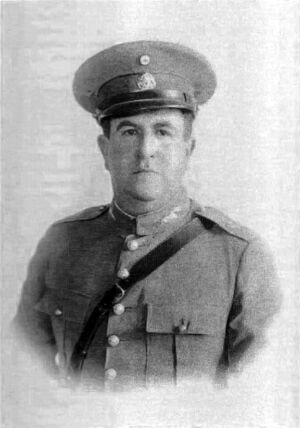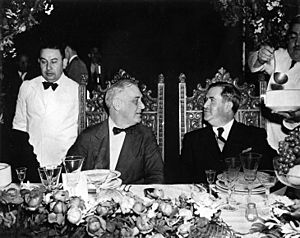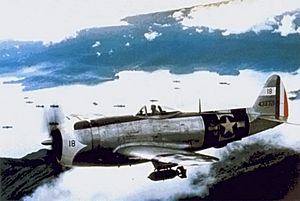Manuel Ávila Camacho facts for kids
Quick facts for kids
Manuel Ávila Camacho
|
|
|---|---|
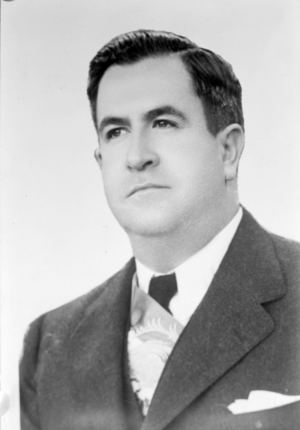
Official portrait, 1940
|
|
| 52nd President of Mexico | |
| In office 1 December 1940 – 30 November 1946 |
|
| Preceded by | Lázaro Cárdenas |
| Succeeded by | Miguel Alemán Valdés |
| Secretary of National Defense of Mexico | |
| In office 18 October 1936 – 31 January 1939 |
|
| President | Lázaro Cárdenas |
| Preceded by | Andrés Figueroa |
| Succeeded by | Jesús Agustín Castro |
| Personal details | |
| Born | 24 April 1897 Teziutlán, Puebla, Mexico |
| Died | 13 October 1955 (aged 58) Huixquilucan, State of Mexico, Mexico |
| Resting place | Panteón Francés |
| Political party | Institutional Revolutionary Party |
| Spouse |
Soledad Orozco
(m. 1925) |
| Military service | |
| Branch/service | |
| Years of service | 1914–1933 |
| Rank | Brigadier General |
Manuel Ávila Camacho (born April 24, 1897 – died October 13, 1955) was a Mexican politician and military leader. He served as the President of Mexico from 1940 to 1946.
He took part in the Mexican Revolution and became a high-ranking general. He became president because he was a close friend and trusted helper of General Lázaro Cárdenas. Mexicans lovingly called him "The Gentleman President."
As president, he worked to unite the country and find balanced solutions. His time in office marked a big change. Mexico moved from having military leaders to civilian ones. He also helped end the disagreements between the government and the church. He changed the policy on education and improved Mexico's relationship with the United States during World War II.
Contents
Manuel Ávila Camacho's Early Life
Manuel Ávila Camacho was born in Teziutlán, a town in Puebla, Mexico. His parents, Manuel Ávila Castillo and Eufrosina Camacho Bello, were middle-class.
He had several brothers and a sister. His older brother, Maximino Ávila Camacho, was a very strong personality. Two of his brothers, Maximino and Rafael Ávila Camacho, later became governors of Puebla.
Manuel Ávila Camacho went to the National Preparatory School. However, he did not get a university degree.
Manuel Ávila Camacho's Early Career
In 1914, he joined the revolutionary army as a second lieutenant. By 1920, he had become a colonel. That same year, he worked as the chief of staff for the state of Michoacán. There, he became a close friend of Lázaro Cárdenas.
He fought against a rebellion in 1923 led by former general Adolfo de la Huerta. In 1929, he fought alongside General Cárdenas again. This was during the Escobar Rebellion, which was the last major military uprising by unhappy generals. In the same year, he earned the rank of brigadier general.
He married Soledad Orozco García (1904–1996). She was from a well-known family in Zapopan, Jalisco.
After his military service, Ávila Camacho started working in government in 1933. He became an executive officer in the Secretariat of National Defense. In 1937, he became the Secretary of National Defense. In 1940, he was chosen to run for president. He represented the party that later became the Institutional Revolutionary Party.
Camacho won the presidential election, which was quite controversial. He defeated General Juan Andreu Almazán, who was a right-wing candidate.
Manuel Ávila Camacho's Presidency
Ending Conflicts Between Church and State
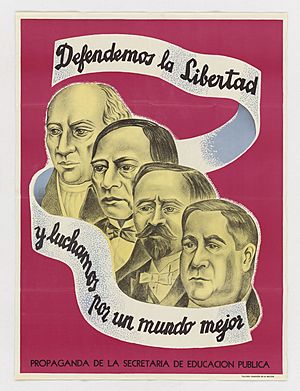
Manuel Ávila Camacho was a Roman Catholic. He openly said, "I am a believer." Before him, all presidents since the revolution had been against the church. During Camacho's time as president, the disagreements between the Roman Catholic Church in Mexico and the Mexican government mostly came to an end.
Domestic Policies in Mexico
President Camacho worked to protect working people. In 1943, he created the Mexican Social Security Institute (IMSS). This organization helps provide healthcare and other benefits.
He also worked to reduce the number of people who could not read or write. He continued to reform how land was distributed. He also froze rents to help people with lower incomes.
He improved election rules. A new election law was passed in 1946. This law made it harder for very right-wing or very left-wing parties to be officially recognized. To be a political party, an organization had to:
- Have at least 10,000 active members in 10 different states.
- Have existed for at least three years before an election.
- Agree with the rules set out in the Mexican constitution.
- Not be controlled by or connected to international groups or foreign political parties.
On January 18, 1946, he changed the name of the Party of the Mexican Revolution (PRM). It became the Institutional Revolutionary Party (PRI), which is its name today. The Mexican army used to be a part of the PRM. However, it was removed from the new PRI organization.
Economically, he pushed for Mexico to become more industrial. This helped a small group of people, but it also made the gap between rich and poor wider.
World War II greatly boosted Mexican industry. It grew by about 10% each year between 1940 and 1945. Mexican raw materials were very important for the US war effort.
In farming, his government invited the Rockefeller Foundation. This group helped bring new farming methods, known as the Green Revolution, to Mexico. This was done to increase how much food Mexico could produce.
In education, Camacho changed the policy of "socialist education." This policy had been put in place by Lázaro Cárdenas. Camacho had the parts of the constitution that required it removed.
Foreign Policies and World War II
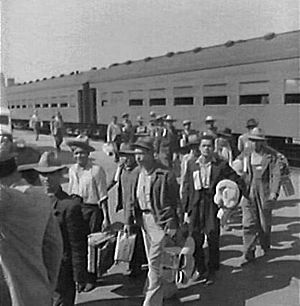
During his presidency, Camacho faced the challenge of leading Mexico during World War II. Two Mexican oil ships were sunk by German submarines in the Gulf of Mexico. Because of this, Camacho declared war against the Axis powers on May 22, 1942.
Mexico's involvement in World War II was mostly through an air squadron. This was the 201st (Escuadrón 201). They went to fight the Japanese in the Pacific. The squadron had 300 men. After training in Texas, they were sent to the Philippines on March 27, 1945. Their missions began on June 7, 1945, and they took part in the Battle of Luzon. By the end of the war, five Mexican soldiers had died in combat. Even though Mexico's part in the war was short, it was on the winning side. This gave Mexico the right to join important international meetings after the war.
Mexico joining the Allies improved its relationship with the United States. Mexico provided raw materials for the war. It also sent 300,000 guest workers to the US. These workers were part of the Bracero program. They helped replace Americans who had gone to fight in the war.
Mexico also started talking again with the United Kingdom and the Soviet Union. These relationships had been stopped during Lázaro Cárdenas's presidency. In 1945, Mexico signed the United Nations Charter. In 1946, it hosted the Inter-American Conference about War and Peace.
Old disagreements with the United States were solved during his time. Especially in the early years of World War II, Mexico and the US had a great relationship. The United States gave Mexico money to improve its railway system. They also helped build the Pan American Highway. Mexico's foreign debt was also reduced.
Manuel Ávila Camacho's Later Life
When his term as president ended in 1946, Camacho retired. He went to work on his farm.
Awards and Honors
- 1945, Order of Propitious Clouds with Special Grand Cordon from the Republic of China
- Poland (in exile): Order of the White Eagle
See Also
 In Spanish: Manuel Ávila Camacho para niños
In Spanish: Manuel Ávila Camacho para niños


